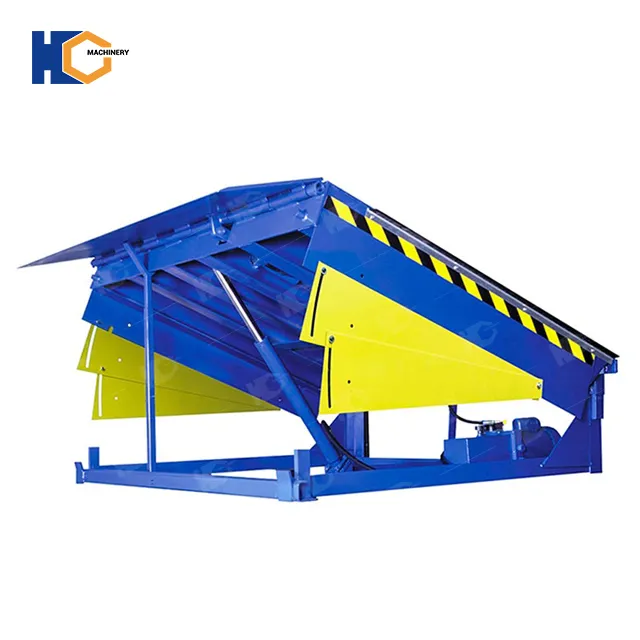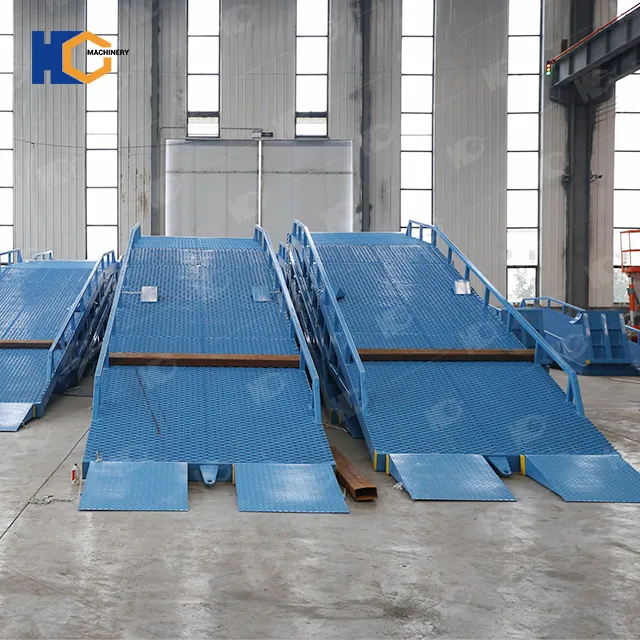Description of Stationary Loading Dock Ramps
Stationary loading dock ramps are an essential component in the logistics and warehousing industry, providing a safe and efficient way to load and unload goods from trucks or containers. These ramps are permanently fixed to a specific location, usually at a loading dock, to facilitate the smooth transfer of materials between different levels. This guide will explore the importance, types, benefits, and considerations when selecting stationary loading dock ramps for your facility.
1. Importance of Stationary Loading Dock Ramps
In any warehouse or distribution center, the movement of goods is a critical operation. Stationary loading dock ramps play a pivotal role in ensuring that this movement is seamless. They bridge the gap between a truck bed and the loading dock, allowing forklifts, pallet jacks, and other equipment to easily transport goods. Without these ramps, loading and unloading operations would be more time-consuming, labor-intensive, and hazardous.
Here is a table displaying common specifications for stationary loading dock ramps:
| Specification | Details |
|---|---|
| Length | 20 ft, 25 ft, 30 ft, 35 ft, 40 ft |
| Width | 6 ft, 7 ft, 8 ft |
| Capacity | 10,000 lbs, 15,000 lbs, 20,000 lbs, 25,000 lbs |
| Height Adjustment | 42 inches to 58 inches |
| Material | Steel, Aluminum |
| Surface Type | Serrated steel grating, Diamond plate, Textured aluminum |
| Finish | Painted, Powder-coated |
| Lip Length | 12 inches, 14 inches, 16 inches |
| Usable Width | 72 inches, 84 inches |
| Ramp Slope | 10° - 15° (depending on length) |
| Safety Features | Side curbs, Safety chains, Anti-slip surface |
| Installation Type | Bolt-on, Welded |
These specifications can vary based on the manufacturer and specific model of the ramp.
2. Types of Stationary Loading Dock Ramps
Stationary loading dock ramps come in various designs to suit different applications. The most common types include:
Standard Dock Ramps: These are the most commonly used ramps, featuring a simple design that accommodates a wide range of vehicles and loading equipment.
Heavy-Duty Dock Ramps: Built for more demanding applications, these ramps are designed to handle heavier loads, often used in industrial settings with large, heavy equipment.
Customized Dock Ramps: For specialized needs, ramps can be customized in terms of size, weight capacity, and surface material to meet specific operational requirements.
3. Benefits of Stationary Loading Dock Ramps
Investing in stationary loading dock ramps offers several advantages:
Increased Efficiency: By providing a smooth transition between different levels, these ramps significantly speed up the loading and unloading process, reducing overall handling time.
Enhanced Safety: With stationary dock ramps, the risks associated with manual lifting and uneven surfaces are minimized, leading to a safer working environment.
Durability and Longevity: Constructed from robust materials such as steel or aluminum, stationary loading dock ramps are built to withstand heavy use and harsh conditions, offering long-term reliability.
Cost-Effective: While the initial investment may be higher than portable ramps, the durability and reduced maintenance costs of stationary ramps make them a cost-effective solution in the long run.
4. Key Considerations When Choosing a Stationary Loading Dock Ramp
Selecting the right stationary loading dock ramp for your facility involves several key considerations:
Load Capacity: Ensure that the ramp can handle the maximum weight of your vehicles and cargo to avoid overloading and potential accidents.
Ramp Length and Gradient: The length and slope of the ramp should be appropriate for your specific operations. A longer ramp with a gentler slope is ideal for safer and easier vehicle access.
Surface Material: The ramp’s surface should provide adequate traction to prevent slipping, especially in wet or icy conditions. Common options include serrated steel grating or textured aluminum.
Installation Requirements: Consider the installation process and whether the ramp can be easily integrated into your existing loading dock setup.
Maintenance Needs: Opt for ramps that require minimal maintenance, ensuring long-term operational efficiency without frequent downtime.
5. Conclusion
Stationary loading dock ramps are a critical investment for any business involved in heavy logistics and warehousing. They enhance operational efficiency, improve safety, and provide long-lasting service. By carefully considering factors such as load capacity, ramp length, and surface material, you can select the right stationary loading dock ramp to meet your specific needs, ensuring that your loading and unloading processes are as smooth and efficient as possible.
Customizing Stationary Loading Dock Ramps: Process and Key Considerations
1. Initial Consultation
Start by discussing your specific needs with the manufacturer. Provide details such as the type of goods you handle, the weight of the loads, and the dimensions of your loading area. This helps the manufacturer understand your requirements and offer tailored solutions.
2. Design and Specification
Based on your input, the manufacturer will design the ramp, considering factors like length, width, load capacity, and surface type. They may also suggest additional features like side curbs or safety chains. Review the design carefully and ensure it meets your operational needs.
3. Quotation and Agreement
Once the design is finalized, the manufacturer will provide a quotation. This includes the cost of materials, labor, and any customization. Review the quote and, if acceptable, proceed to sign an agreement outlining the project scope, timeline, and payment terms.
4. Production
The factory will begin manufacturing the ramp according to the agreed-upon specifications. Regular updates may be provided during production. Ensure that the manufacturing process adheres to quality standards and timelines.
5. Quality Inspection
Before shipping, conduct a quality inspection to ensure the ramp meets your specifications and safety requirements. This can be done either in person or through a third-party inspector.
6. Delivery and Installation
Once the ramp passes inspection, it will be delivered to your site. Coordinate with the manufacturer for installation, which may involve bolting or welding the ramp to your loading dock.
7. Final Check and Operation
After installation, perform a final check to ensure the ramp is securely installed and operates smoothly. Conduct a brief training session for your staff on safe usage and maintenance.
Key Considerations
Load Capacity: Ensure the ramp can handle your heaviest loads.
Ramp Length and Slope: Choose a length and gradient that suit your loading equipment.
Material and Surface: Select materials that offer durability and anti-slip properties.
Safety Features: Consider adding side curbs, safety chains, or handrails for extra protection.
Compliance: Ensure the ramp meets local safety and building regulations.
By following these steps and paying attention to the key considerations, you can successfully customize a stationary loading dock ramp that meets your operational needs.
About JNHC Lift factory
JNHC Lift is a leading stationary loading dock ramp factory, specializing in the customization of stationary loading dock ramps to meet the unique needs of our clients. We offer a comprehensive range of after-sales services, ensuring that our products not only meet but exceed your expectations in terms of performance and durability. Our team is dedicated to providing tailored solutions, from design to installation, ensuring a seamless and efficient loading and unloading process for your business. We invite you to partner with us for reliable, high-quality loading dock ramps that are built to last.

